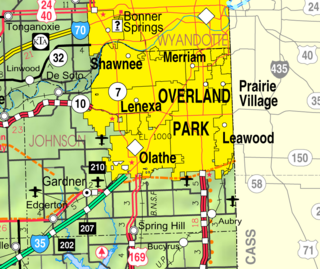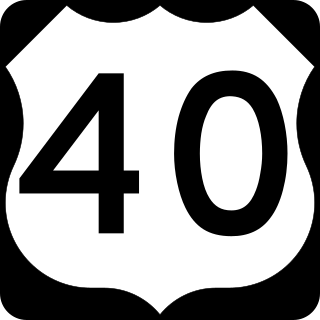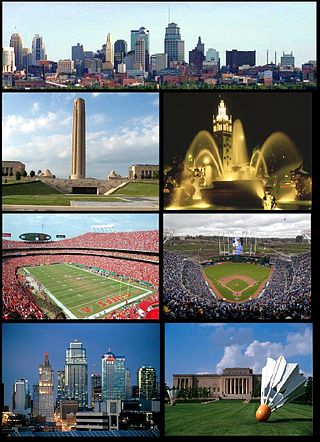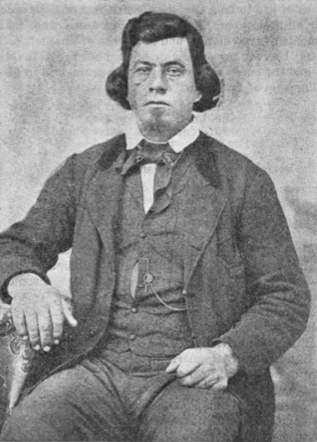
Wyandotte is a city in Wayne County in the U.S. state of Michigan. The population was 25,058 at the 2020 census.

Wyandotte County is a county in the U.S. state of Kansas. Its county seat and most populous city is Kansas City, with which it shares a unified government. As of the 2020 census, the population was 169,245, making it Kansas's fourth-most populous county. The county was named after the Wyandot tribe.

Miami County is a county located in east-central Kansas and is part of the Kansas City metropolitan area. Its county seat and most populous city is Paola. As of the 2020 census, the county population was 34,191. The county was named for the Miami tribe.

Johnson County is a county in the U.S. state of Kansas, along the border of the state of Missouri. Its county seat is Olathe. As of the 2020 census, the population was 609,863, the most populous county in Kansas. The county was named after Thomas Johnson, a Methodist missionary who was one of the state's first settlers. Largely suburban, the county contains a number of suburbs of Kansas City, Missouri, including Overland Park, a principal city of and second most populous city in the Kansas City Metropolitan Area.

Shawnee is a city in Johnson County, Kansas, United States. It is the seventh most populous municipality in the Kansas City metropolitan area. As of the 2020 census, the population of the city was 67,311.

Kansas City is the third-most populous city in the U.S. state of Kansas, and the county seat of Wyandotte County. It is an inner suburb of the older and more populous Kansas City, Missouri, after which it is named. As of the 2020 census, the population of the city was 156,607, making it one of four principal cities in the Kansas City metropolitan area. It is situated at Kaw Point, the junction of the Missouri and Kansas rivers. It is part of a consolidated city-county government known as the "Unified Government". It is the location of the University of Kansas Medical Center and Kansas City Kansas Community College.
In American folklore, the Golden Bear was a large golden Ursus arctos. Members of the Ursus arctos species can reach masses of 130–700 kilograms (290–1,540 lb). The grizzly bear and the Kodiak bear are North American subspecies of the brown bear.

U.S. Route 40 or U.S. Highway 40 (US 40), also known as the Main Street of America, is a major east–west United States Highway traveling across the United States from the Mountain States to the Mid-Atlantic States. As with most routes whose numbers end in a zero, US 40 once traversed the entire United States. It is one of the first U.S. Highways created in 1926 and its original termini were in San Francisco, California, and Atlantic City, New Jersey. US 40 currently ends at a junction with I-80 in Silver Summit, Utah, just outside Salt Lake City. West of this point US 40 was functionally replaced with I-80, and as these segments of I-80 were constructed the western portion of US 40 was truncated several times.

The Kansas City metropolitan area is a bi-state metropolitan area containing Kansas City, Missouri. Its 14 counties straddle the border between the U.S. states of Missouri and Kansas having its core in both states.. With 8,472 square miles (21,940 km2) and a population of more than 2.2 million people, it is the second-largest metropolitan area with its 1950s dominant historic core city in Missouri and is the largest metropolitan area in Kansas, though Wichita is the largest metropolitan area with its 1950s dominant historic core city in Kansas. Alongside Kansas City, Missouri, these are the suburbs with populations above 100,000: Overland Park, Kansas; Kansas City, Kansas; Olathe, Kansas; Independence, Missouri; and Lee's Summit, Missouri.

The Wyandotte Nation is a federally recognized Native American tribe headquartered in northeastern Oklahoma. They are descendants of the Wendat Confederacy and Native Americans with territory near Georgian Bay and Lake Huron. Under pressure from Haudenosaunee and other tribes, then from European settlers and the United States government, the tribe gradually moved south and west to Michigan, Ohio, Kansas, and finally Oklahoma in the United States.

Argentine is a community of Kansas City, Kansas, located in the southern part of Wyandotte County. It is bordered on the west by the Turner community, on the east by the Rosedale community, on the south by Johnson County, and on the north by Armourdale community and by the Kansas River.

Interstate 635 (I-635) is a connector highway between I-35 in Overland Park, Kansas, and I-29 in Kansas City, Missouri, approximately 12 miles (19 km) long. It is mostly in the US state of Kansas, servicing the city of Kansas City, Kansas, but extends into Kansas City, Missouri, as well. The freeway's southern terminus is at a stack interchange with I-35. South of this, the mainline becomes an expressway carrying U.S. Route 69 (US 69).
Monticello Township is a former township in northwest Johnson County, Kansas. It is now merged with Lenexa and Shawnee, Kansas.

Shawnee Methodist Mission, also known as the Shawnee Mission, which later became the Shawnee Indian Manual Labor School, is located in Fairway, Kansas, United States. Designated as a National Historic Landmark in 1968, the Shawnee Methodist Mission is operated by the city as a museum. The site is owned by the Kansas Historical Society and administered as the Shawnee Indian Mission State Historic Site.

Grinter Place is a house on the National Register of Historic Places above the Kansas River in the Muncie neighborhood of Kansas City, Kansas.
Ambrose W. Key was an American pioneer. He was born in Crawfordsville, Indiana, the son of George Key and his wife Rebecca Mintun. George, a native of Virginia, settled with his family in Ohio circa 1800. From there, he began a career as a trader, traveling various rivers while establishing his trade routes. In 1836, George spotted lands in Iowa which reminded him of his boyhood home in Virginia, staking a claim to what he dubbed "Virginia Grove" in Louisa County. George planted crops there in 1836 and 1837, and wintered with his family back in Montgomery County, Indiana. While raising his crops in 1838, George sent for his wife and family to come to Iowa. Rebecca hired 10 men to help her move her family of 10 children, including Ambrose, 300 miles (480 km) from Indiana to Iowa. They averaged 7 miles per day on their 45-day trek, employing three wagons and a carriage, while driving a collection of young horses, cattle, and nearly 100 head of sheep.
Armourdale community is a district in the lower part of the Kansas River valley in Kansas City, Kansas. It is a main district between the West Bottoms and the Rosedale, Kansas area. The Kansas River makes an oxbow curve around the entire district, which is home to Shawnee Park and Bill Clem Park.

Charles Blue Jacket was a Shawnee chief in Kansas, as well as a Methodist minister. He was the grandson of the Shawnee Chief Blue Jacket by his son George Blue Jacket. Charles' mother is unknown, but is believed to have been a Shawnee. His maternal grandmother was the daughter of a Shawnee woman and Jacques Baby.

Kansas City, Kansas Public Library (KCKPL) is the public library system of Kansas City, Kansas, headquartered in the Main Library. The library serves Wyandotte County, Kansas. It is governed by the Board of Education of Kansas City Kansas Public Schools and reports to the Wyandotte County Library Board



















